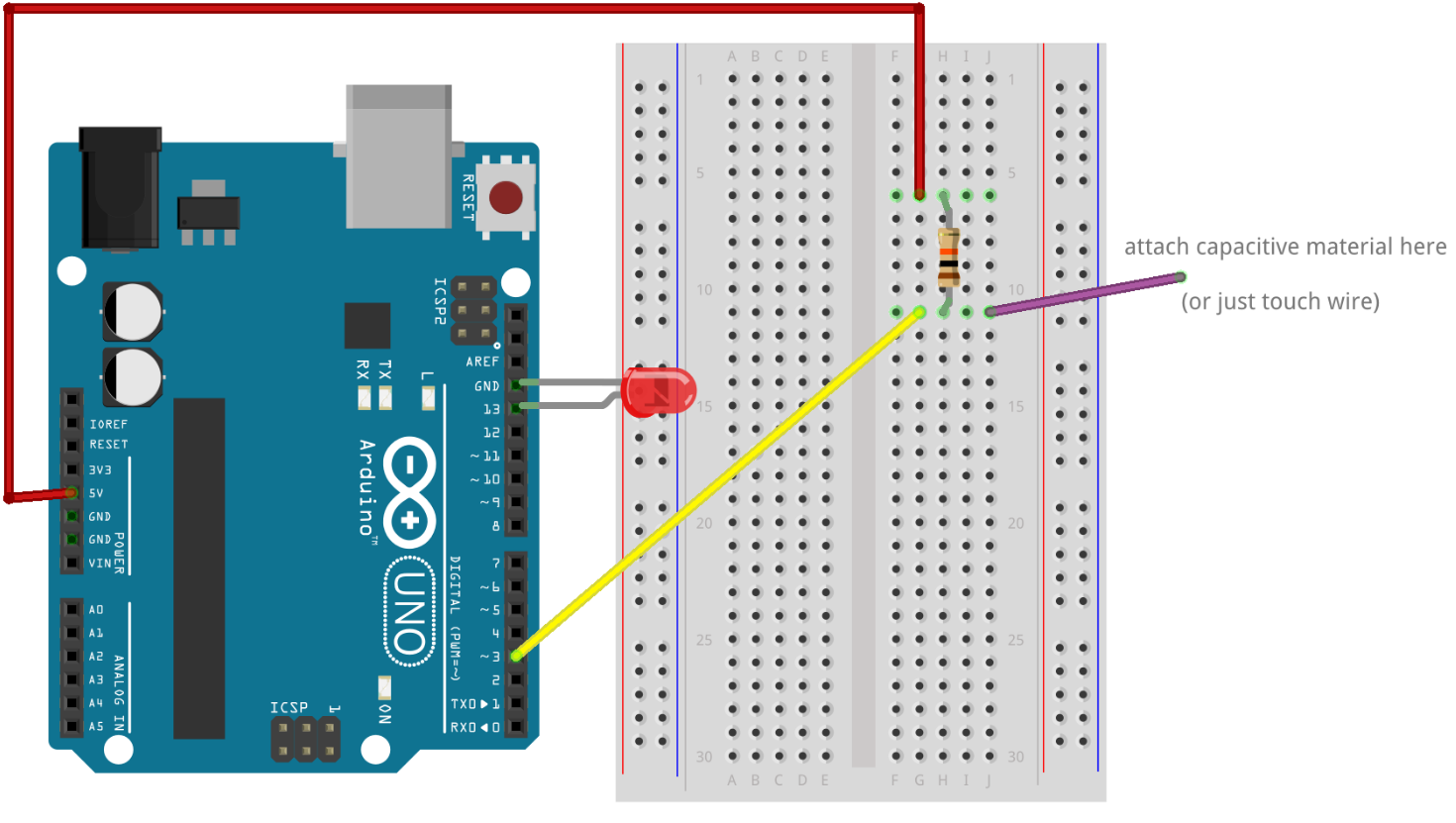Simple Capacitive Touch Example

Simple Arduino example adapted from here to turn an LED on/off using capacitive touch sensing
Components
1 x 10k or 1M ohm resistor
1 LED
1 x Arduino Uno
1 x breadboard
jumper wires
Setup

Arduino sketch
Note: you may need to play with the touchedCutoff value. This works with at 10k ohm resistor, but could be made more sensitive with a 1 megaohm resistor.
/**
* Capacitive touch example, adapted by Eva Snyder from
* http://www.instructables.com/id/Turn-a-pencil-drawing-into-a-capacitive-sensor-for/
**/
// Pin for the LED
int LEDPin = 13;
// Pin to connect to your conductive sensor
// (paperclip, conductive paint/fabric/thread, wire)
int capSensePin = 2;
// This is how high the sensor needs to read in order
// to trigger a touch. You'll find this number
// by trial and error, or you could take readings at
// the start of the program to dynamically calculate this.
// If this is not sensitive enough, try a resistor with more ohms.
int touchedCutoff = .5;
void setup(){
Serial.begin(9600);
// Set up the LED
pinMode(LEDPin, OUTPUT);
digitalWrite(LEDPin, LOW);
}
void loop(){
// If the capacitive sensor reads above a certain threshold,
// turn on the LED
if (readCapacitivePin(capSensePin) > touchedCutoff) {
digitalWrite(LEDPin, HIGH);
}
else {
digitalWrite(LEDPin, LOW);
}
// Every 500 ms, print the value of the capacitive sensor
if ( (millis() % 500) == 0){
Serial.print("Capacitive Sensor reads: ");
Serial.println(readCapacitivePin(capSensePin));
}
}
// readCapacitivePin
// Input: Arduino pin number
// Output: A number, from 0 to 17 expressing
// how much capacitance is on the pin
// When you touch the pin, or whatever you have
// attached to it, the number will get higher
// In order for this to work now,
// The pin should have a resistor pulling
// it up to +5v.
uint8_t readCapacitivePin(int pinToMeasure){
// This is how you declare a variable which
// will hold the PORT, PIN, and DDR registers
// on an AVR
volatile uint8_t* port;
volatile uint8_t* ddr;
volatile uint8_t* pin;
// Here we translate the input pin number from
// Arduino pin number to the AVR PORT, PIN, DDR,
// and which bit of those registers we care about.
byte bitmask;
if ((pinToMeasure >= 0) && (pinToMeasure <= 7)){
port = &PORTD;
ddr = &DDRD;
bitmask = 1 << pinToMeasure;
pin = &PIND;
}
if ((pinToMeasure > 7) && (pinToMeasure <= 13)){
port = &PORTB;
ddr = &DDRB;
bitmask = 1 << (pinToMeasure - 8);
pin = &PINB;
}
if ((pinToMeasure > 13) && (pinToMeasure <= 19)){
port = &PORTC;
ddr = &DDRC;
bitmask = 1 << (pinToMeasure - 13);
pin = &PINC;
}
// Discharge the pin first by setting it low and output
*port &= ~(bitmask);
*ddr |= bitmask;
delay(1);
// Make the pin an input WITHOUT the internal pull-up on
*ddr &= ~(bitmask);
// Now see how long the pin to get pulled up
int cycles = 16000;
for(int i = 0; i < cycles; i++){
if (*pin & bitmask){
cycles = i;
break;
}
}
// Discharge the pin again by setting it low and output
// It's important to leave the pins low if you want to
// be able to touch more than 1 sensor at a time - if
// the sensor is left pulled high, when you touch
// two sensors, your body will transfer the charge between
// sensors.
*port &= ~(bitmask);
*ddr |= bitmask;
return cycles;
}

